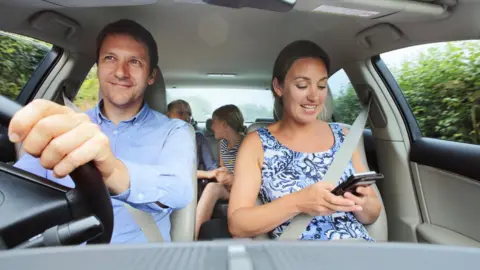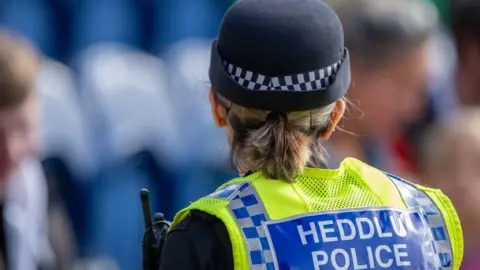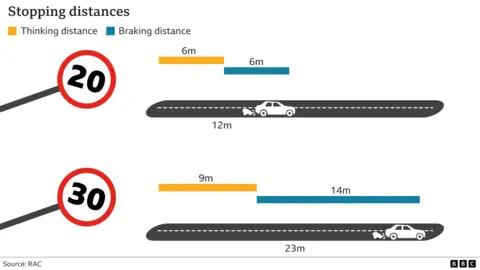How does the new Wales-wide 20mph speed limit law work?
 Getty Images
Getty ImagesMotorists in Wales now have to limit their speed to 20mph in built-up areas such as village and town centres.
In 2022, the Senedd voted to make Wales the first nation in the UK to adopt 20mph as the default speed limit on restricted roads.
It started on 17 September, and has proved controversial - but how does it work?
Here we try our best to answer your queries.
What is the latest?
Ken Skates was named as new transport secretary in March. The next month he said 20mph zones should be targeted at schools, hospitals and nurseries.
He said there would be changes to the existing default 20mph speed limit in built-up areas with the "voice of citizens at the heart of all we do".
On Tuesday 23 April, Mr Skates said the process of switching some 20mph roads back to 30mph would start in September.
He claimed he was "refining" the project and urged people to contact councils to tell them which streets should be examined.
But the Tories said the 20mph default limit would stay and nothing had changed.
What is a restricted road?
The 20mph limit has come into force for all restricted roads, which are defined as roads with lampposts placed not more than 200 yards (about 180m) apart.
They are typically located in residential and built-up areas of high pedestrian activity.
When did the change start?
The 20mph limit began on 17 September 2023. The new law to make Wales the first nation to impose 20mph as the default on all restricted roads was passed by the Welsh Parliament in July 2022.
The proposal was given the go-ahead by 39 votes to 15, after initial backing in the Senedd two years previously.
 Getty Images
Getty ImagesWhat law has been changed?
The Road Traffic Regulation Act 1984 said it was not lawful to drive a on a restricted road at more than 30mph. That was later amended to 20mph.
Is the 20mph speed limit being enforced?
Enforcement began on 8 January, 2024, and roadside teams will use speed monitoring equipment to catch offending motorists.
If you are pulled over doing more than 20mph in a built-up area in Wales you could, in theory, be fined a minimum £100 and get three penalty points.
But police said their response will be proportionate and reasonable while drivers get used to the change as the focus for the first 12 months will be on education - as officers have a level of discretion.
"Where we find people driving above 20mph, we will stop drivers and speak to them about the dangers and risks about driving above the speed limit," said South Wales Police Assistant Chief Constable Mark Travis.
"We won't be taking enforcement action against those people who are actually engaging with us and trying to bring their speed down - so they won't receive a fine.
"The people who will be fined will be those driving at the highest levels. Ultimately, if necessary, we will enforce - but that is always a last resort for us."
While police officers across Wales will initially be advised to use "discretion", all drivers will be fined if they are caught by a fixed speed camera.
Receiving 12 or more points within three years may disqualify you from driving.
 Getty Images
Getty ImagesIf you are caught by a camera, depending on the speed, you will be sent an option for a speed awareness course, a fixed penalty notice or a letter telling you to go to court.
If you are stopped by the police they can give you a verbal warning, send you a fixed penalty notice, offer a speed awareness course or order you to go to court.
Instead of fines, speeding drivers will be offered the chance to watch a video about the dangers of speeding and the benefits of slowing down.
What speed will I get prosecuted for in a 20mph zone?
Welsh government minister Lee Waters said there will be an "education led" approach to enforcement, as "there's no incentive for us to fine because the money won't stay in Wales".
"Police guidelines say enforcement will be targeted on drivers travelling 10% above the speed limit - plus 2mph," he said.
"For now this will be increased to 10% plus 4mph meaning we start to prosecute at 26mph in a 20mph limit."
Where does the money collected from fines go?
As Mr Waters alluded to, the money collected from speeding fines in Wales goes to the UK government.
A Welsh government spokesperson said: "The money generated by 20mph speeding fines, as with all speeding fines, is directed to HM Treasury."
Does Wales' 20mph speed limit apply to bicycles?
Speed limits in the Road Traffic Regulations and the Highway Code apply to motor vehicles only, and not to bicycles. But the Highway Code does state that cyclists should be considerate of other road users.
Are any restricted roads not 20mph?
The Welsh government has acknowledged the new lower limit is not appropriate everywhere and has said local authorities can make exceptions, though not outside schools.
For example, Flintshire council identified 15 roads that could be exempt from the new policy.
The Welsh government has produced an interactive map showing the status of current and proposed exemptions to the 20mph speed limit.
Do people comply with 20mph speed limits?
There has been a pilot scheme running in eight areas of Wales since 2021. They are St Dogmaels in Pembrokeshire, St Brides Major in the Vale of Glamorgan, Llanelli (north), Buckley in Flintshire, Cardiff (north), Cilfrew in Neath Porth Talbot, Abergavenny and Severnside (Caerwent, Caldicot, Magor and Undy) in Monmouthshire.
Interim data shows the number of drivers complying with the 20mph speed limit rose from 45% at the start of the trial to 64%.
Many areas of London now have 20mph as the default speed for residential roads, while Scotland plans to follow Wales' lead and make the policy nationwide by 2025.
Many cities and towns across the UK now have 20mph zones as the norm for residential areas even if the local authority does not have a blanket policy across the whole area.
How much has the 20mph law change cost?
The cost of bringing it in has been estimated at £33m.
The Welsh Government said the £32.5m price tag was "outweighed" by reduced impact on the NHS and emergency services, which one study said could save £92m a year.

Who is paying for it?
The Welsh government said the direct financial cost of the policy falls "almost entirely" on its shoulders, and it is funding the capital works carried out by the local authorities through grants.
How much does lower speed reduce risk?
Latest police data from 2022 showed just over half - 51% - of the 4,442 people hurt in collisions in Wales happened on 30mph roads and in 23% of them, someone was killed or seriously injured. The total number of injuries fell by 23.5% compared to 2019.
Campaigners argue the chances of someone surviving being hit by a car at 20mph rather than 30mph is seven times higher while stopping distances are almost halved.
Why do some ministers think it will benefit the environment?
Ministers in the Senedd have been promoting sustainable travel - such as cycling or walking - after Wales declared a climate emergency in 2019 and aims to become carbon net zero by 2050.
They think a lower limit might encourage a change in behaviour.

- TREE ON A HILL: In the blink of an eye, Margaret and Clive are on the wrong side of the law
- MICHAEL SHEEN'S DIRECTORIAL DEBUT: An ordinary family caught up in extraordinary events

